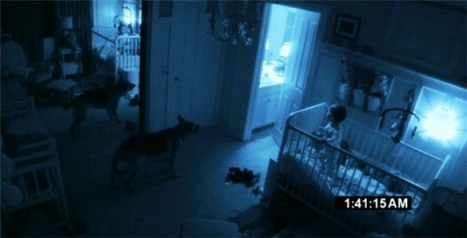I was surprised to find myself eager, even impatient, to watch Paranormal Activity 2, the followup to 2007’s no-budget breakthrough in surveillance horror. I wrote of the first movie that it delivered a satisfactory double-action of filmic and commercial engineering, chambering and firing its purchased scares in a way that felt requisitely unexpected and, at the same time, reassuringly predictable. The bonus of seeing it in a theater (accompanied by my mom, and my therapist would like to know why I chose to omit that fact from the post) was a happy reminder that crowds can improve, rather than degrade, the movie experience.
PA2 I took in at home after my wife had gone to bed. I lay on a couch in a living room dark except for the low light of a small lamp: a setting well-suited to a drama that takes place largely in domestic spaces at night. My complete lack of fear or even the faint neck-tickle of eeriness probably just proves the truism that some movies work best with an audience — but let’s not forget that cinema does many kinds of work, and offers many varieties of pleasure. This is perhaps especially true of horror, whose glandular address of our viscera places it among the body genres of porn and grossout comedy (1), and whose narratives of inevitable peril and failed protection offer a plurality of identifications where X marks the intersection of the boy-girl lines of gender and the killer-victim lines of predation (2).
I’m not sure what Carol Clover would make of Paranormal Activity 2 or its predecessor (though see here for a nice discussion), built as they are on the conceit of a gaze so disinterested it has congealed into the pure alienness of technology. Shuffled among the mute witnesses of a bank of home-security cameras, we are not in the heads of Alfred Hitchcock, Stanley Kubrick, or even Gaspar Noe, but instead the sensorium — and sensibility — of HAL. A good part of the uncanniness, and hence the fun, comes from the way this setup eschews the typical constructions of cinematography: conventions of framing and phrasing that long ago (with the rise of classical film style) achieved their near-universal legibility at the cost of their willingness to truly disrupt and disturb. PA2 is grindhouse dogme, wringing chills from its formal obstructions.
Rather than situating us securely in narrative space through establishing shots and analytic closeups, shot-reverse-shot, and point-of-view editing, PA2 either suspends us outside the action, hovering at the ceiling over kitchens and family rooms rendered vast as landscapes by a wide-angle lens, or throws us into the action in handheld turmoil that even in mundane and friendly moments feels violent. The visuals and their corresponding “spatials” position viewers as ghosts themselves, alternately watching from afar in building frustration and hunger, then taking posession of bodies for brief bouts of hot corporality. Plotwise, we may remain fuzzy on what the spectral force in question (demon? haunted house? family curse?) finally wants, but on the level of spectatorial empathy, it is easy to grasp why it both hates and desires its victims.
Along with Von Trier, other arty analogs for PA2 might be Chantal Akerman’s Jeanne Dielman or Laura Mulvey and Peter Wollen’s Riddles of the Sphinx, which similarly locate us both inside and outside domestic space to reveal how houses can be “haunted” by gender and power. They share, that is, a clinical interest in the social and ideological compartmentalization of women, though in the Paranormal Activity films the critique remains mostly dormant, waiting to be activated in the readings of brainy academics. (Certainly one could write a paper on PA2’s imbrication of marriage, maternity, and hysterical “madness,” or on the role of technological prophylaxis in protecting the white bourgeois from an Other coded not just as female but as ethnic.)
But for this brainy academic, what’s most interesting about PA2 is the way it weaves itself into the first film. Forming an alternate “flightpath” through the same set of events, the story establishes a tight set of linkages to the story of Micah and Katie, unfolding before, during, and after their own deadly misadventure of spirit photography gone wrong. It is simultaneously prequel, sequel, and expansion to Paranormal Activity, and hence an example — if a tightly conscribed one — of transmedia storytelling, in which a fictional world, its characters, and events can be visited and revisited in multiple tellings. In comments on my post on 2008’s Cloverfield, Martyn Pedler pointed out that film’s transmedia characteristics, and I suggested at the time that “Rather than continuing the story of Cloverfield, future installments might choose to tell parallel or simultaneous stories, i.e. the experiences of other people in the city during the attack.”
Paranormal Activity 2 does precisely that for its tiny, spooky universe. It may not be the scariest movie I’ve seen lately, but for what it implies about the evolving strategies of genre cinema in an age of new media, it’s one of the more intriguing.
Works Cited
1. Linda Williams, “Film Bodies: Gender, Genre, and Excess,” Film Quarterly 44:4 (Summer 1991), 2-13.
2. Carol J. Clover, Men, Women and Chainsaws: Gender in the Modern Horror Film (Princeton: Princeton University Press, 1993).

